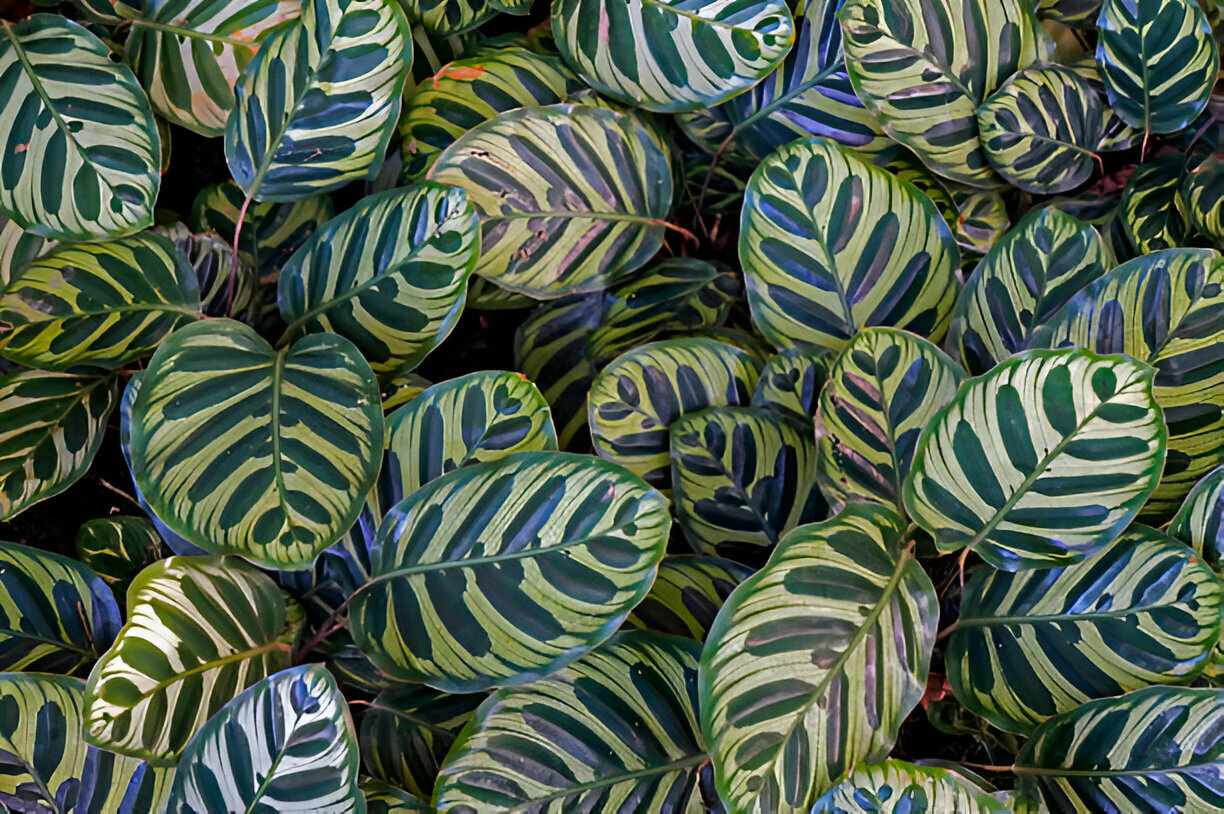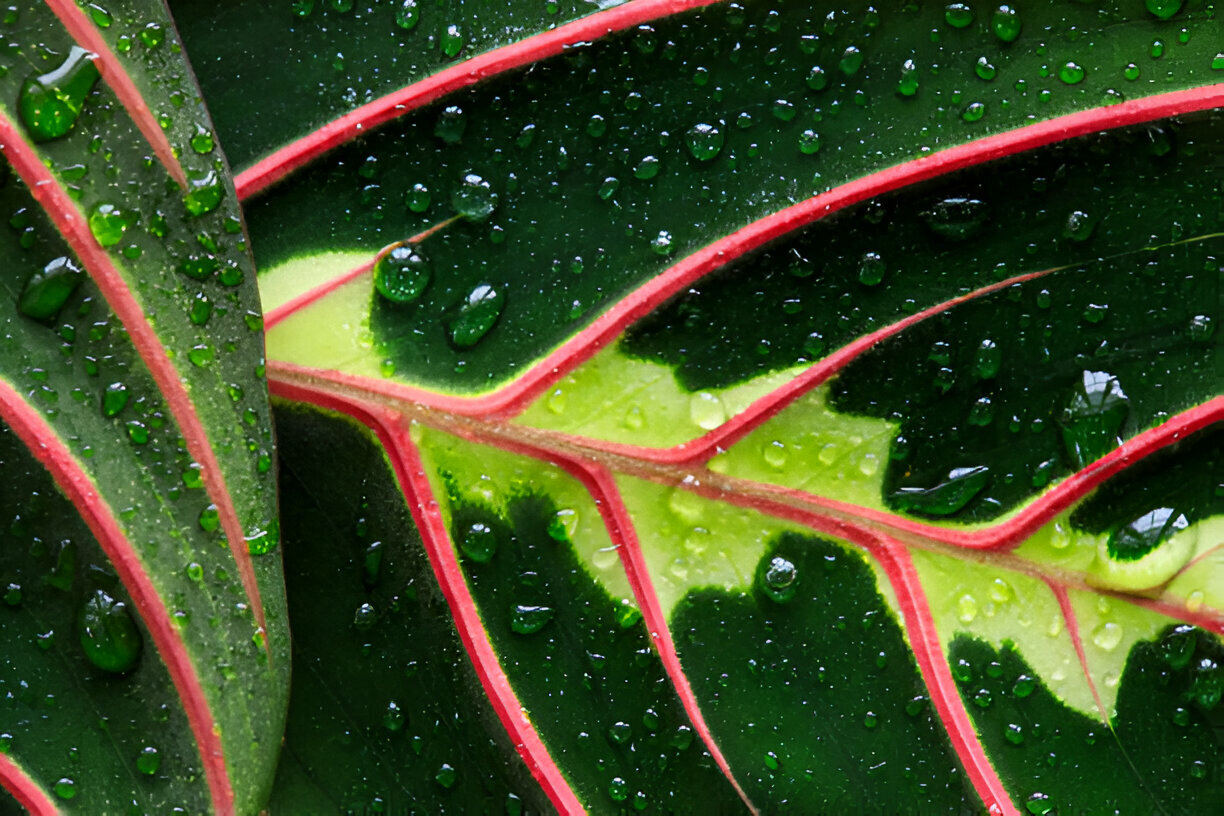Prayer Plant 101: Varieties, Care, & Why They “Pray”
Have you ever been captivated by a houseplant with stunning foliage and unique leaf movements? That’s the magic of the prayer plant, a tropical beauty renowned for vibrant patterns with intricate veins, speckles, and contrasting hues.
If you’ve ever wondered why these plants are called “prayer plants, “how to care for them, or which variety might be perfect for your home, we have all the information you need.
In this Prayer Plant 101 guide, I will explain the extraordinary reason behind their unique name, explore a dazzling array of varieties, and equip you with the knowledge to nurture these living artworks.
Get ready to be enchanted by the prayer plant’s charm and discover how to bring a touch of tropical elegance into your living space.

Why Is It Called A Prayer Plant
Originating from Brazil, the prayer plant gets its common name from how its leaves remain flat during the day to soak up the light. Then, they fold up like praying hands in the evening to conserve energy and moisture. This unique daily movement is known as nytinasty.
Marantas are closely related to calatheas, also commonly referred to as prayer plants. However, there are two main differences between them. One is that the leaves of calatheas do not close up at night. Two, marantas have a more spreading growth habit than that of calatheas.
Check how to revive a prayer plant.
Prayer Plant Indoor Or Outdoor?
Prayer plants are primarily indoor plants, especially in regions with temperate climates. As they originate from tropical rainforests, they will thrive more in the warmer conditions typically found inside homes. They can be grown under greenhouse conditions, too.
While they can be placed outdoors in some areas in summer, they are sensitive to direct sunlight and extreme temperatures. When moving them outside, keeping them in a shaded spot with protection from harsh winds and extreme heat is best.
It is generally easier to grow maranta indoors to provide the following needs:
- Temperature Sensitivity: They prefer temperatures between 65-85°F (18-29°C) and will struggle in colder conditions. They can also be sensitive to direct cold draughts from open doors or air vents.
- Humidity Requirements: Higher humidity levels suit Marantas best, and they are often easier to maintain indoors. To increase humidity levels, mist their leaves or stand the pots on top of pebbles in a water tray. Alternatively, keep a small container of water nearby.
- Light Sensitivity: Marantas thrive in filtered light and sunlight in their natural habitat. Direct sunlight can scorch their delicate leaves, so ideally, they should be placed in bright light or partial shade.
- Watering needs: Marantas require moist but not soggy soil, so water only when the topsoil is dry to a depth of around 2 inches. Distilled or filtered water is best, as Marantas are also sensitive to chemicals in tap water. If you only have tap water, pour it into a container and leave it uncovered for 24 hours. The chlorine in the water will then evaporate before use.
- Soil requirements: Marantas prefer soil that remains moist but also drains away. Choose a purpose-mixed potting soil suitable for tropical plants.
Prayer Plant Varieties: A Kaleidoscope of Colors and Patterns
There are numerous varieties of Maranta to choose from, and some of the most popular are listed here. Some are easy to grow, and some are more challenging.
- Black Maranta (Maranta leuoneura ar. Massangeano): A rare variety that can be challenging to grow but worth the effort. It is a stunning plant with silver-green veins and striking medium green and black markings. Full size 12 inches (30 cm).
- Red Maranta (Maranta leuconeura var. Erythroneura): Sometimes referred to as Maranta Tricolor or Fishbone Prayer Plant. It is the most colorful and one of the most common prayer plants. The large oval leaves have pink veins resembling a fishbone pattern imprinted against darker green leaves. Full size 15 inches (38 cm).
- Maranta Lemon Lime (Maranta leuconeura var. Erythroneura ‘Lemon Lime’): This is an easy-to-grow newer cultivator of the above Red Maranta subspecies. It differs in that the pink veins have more of a light yellow-green mixed in. This variety will also tolerate lower humidity levels. Full size 12 inches (30 cm).
- Beauty Kim (Maranta leuconeura var. Kerchoveana ‘Variegata’): This is a reasonably easy-to-grow variegated variety with green and creamy blotched leaves. Full size 12 inches (30 cm).
- Silver Band (Maranta leuconeura var. Massamgeama ‘Silver Band’): A cultivator of Black Maranta whereby the black markings are replaced with the silver band. This reasonably easy-to-grow variety is particularly sensitive to fertilizers. Therefore, it is essential to use a water-based fertilizer diluted to half-strength. Full size 12 inches (30 cm).
- Maranta ‘Fascinator’ (Maranta leuconeura var. erythroneura): This is known as the herringbone plant with yellow-green splotches along the midrib and bright red veins. Full size 12 inches (30 cm).
- Green Maranta (Maranta leuconeura var. Kerchoveana): Commonly known as Rabbit’s Tracks. This is a popular and easy-to-grow plant that lacks the usual colored veins. Instead, it has striking dark markings on either side of the mid-rib. Full size 12 inches (30 cm).
What are the ways to prevent root rot without repotting?

Prayer Plant Problems: Troubleshooting Common Issues
Generally, prayer plant varieties are fairly easy to care for. However, they can sometimes experience problems that affect their health and appearance. Here are some common problems and how to address them:
Brown Leaf Tips or Edges
- Cause: The most common cause is usually dry air. Prayer plants thrive in humid environments; dry air can dry and brown their leaves. It could also be caused by over-fertilizing or watering too much.
- Solution: To increase humidity, mist the leaves daily, but make sure no direct sun gets on them while they are damp, as this could cause further browning. Alternatively, leave a container of water nearby.
Reduce the strength of the fertilizer to half of the recommended instructions, too. Water using only distilled, filtered, or tap water that has been left out overnight for the chlorine to evaporate. Avoid placing the plant near drafts or heating vents.
Yellowing Leaves
- Cause: Overwatering is often the main culprit behind yellowing leaves. Too much water can drown the roots, preventing nutrient and water uptake. In time, this will very likely lead to the roots rotting and the stem turning mushy.
- Solution: Between waterings, allow the soil to dry out slightly. Check the pot has drainage holes and that the roots are not poking through. If root rot is suspected, repot the plant in fresh soil and trim any damaged roots.
Curling Leaves
- Cause: Curling leaves indicate underwatering, low humidity, or excessive sunlight.
- Solution: Check the soil moisture and adjust watering accordingly. Increase humidity and protect the plant from direct sunlight, especially midday.
Pale or Fading Colors
- Cause: Insufficient light can cause the vibrant colors of prayer plant leaves to fade. The intensity may differ according to the prayer plant varieties.
- Solution: Move the plant closer to the light but avoid the direct light of the sun.
Pests
- Common Pests: Spider mites, mealybugs, and scale insects can infest prayer plants.
- Solution: Regularly check the plant for signs of pests. If found, isolate the affected plant. If it is a small infestation, remove it by hand or treat it with insecticidal soap or neem oil.
Fungal Diseases
- Common Diseases: Leaf spot and root rot are the two main fungal diseases that can affect prayer plants.
- Solution: Avoid overwatering and ensure good air circulation around the plant. Remove any affected leaves promptly. If the problem persists, use a fungicide according to the instructions.
Drooping Leaves
- Cause: Drooping leaves can indicate underwatering, overwatering, or temperature stress.
- Solution: Check the soil moisture and adjust watering accordingly. Ensure the plant is not exposed to extremes in temperatures or to drafts.
How To Propagate Prayer Plant?
Prayer plants (Maranta) are relatively easy to propagate, and there are a couple of methods you can use:
Division
Best Time: Early spring when the plant is actively growing.
Steps:
- Gently remove the plant from its pot.
- Carefully separate the root ball into smaller sections, ensuring each has healthy roots and a few stems.
- Plant each divided part into a separate pot with a well-draining potting mix.
- Water thoroughly and place in bright, indirect light.
Stem Cuttings
Best Time: Springtime or early summer.
Steps:
- Choose a healthy stem with at least two nodes (the bump on the stem where the leaves join).
- Cut the stem just below a node with a clean, sharp knife or scissors.
- Remove the lower leaves, leaving a few at the top.
- You can either:
Root in water: Place the cutting in a glass of water, ensuring the node is submerged. Change the water every few days. Roots should then develop in a few weeks.
Root in soil: The cut end should be lightly dipped in rooting hormone and planted in a pot with a moist potting mix. Cover the pot with a plastic bag to create humidity.
- Once roots have developed (about 4-6 weeks), the cutting can then be transplanted into a larger pot.

Are Prayer Plants Toxic To Cats or Dogs?
Prayer plants are not known to be toxic to cats or dogs. You can safely keep them in your home without being concerned about your pets getting sick if they nibble on the leaves.
This is good news for pet owners and plant lovers alike! Prayer plants are beautiful, relatively easy to care for, and safe for curious cats and dogs who might like to explore their surroundings.
While prayer plants are not poisonous, excessive chewing on any plant can cause mild digestive upset in cats or dogs. If you notice your pet frequently nibbling on your prayer plant, try offering them alternative options like cat grass or catnip. Or place the plant out of reach.
Final Words
From their captivating “prayer” movements to their kaleidoscope of colors and patterns, prayer plants are a wonder of nature.
No matter if you’re drawn to the classic elegance of the Red Prayer Plant, the playful charm of Rabbit’s Tracks, or the dramatic flair of the Black Maranta, there’s a prayer plant variety to suit every taste and style.
By understanding their unique needs and following the care tips outlined, you can ensure your prayer plant will reward you with outstanding beauty. Be warned, though, that with such a selection to choose from, it will be difficult to settle for just one plant!
